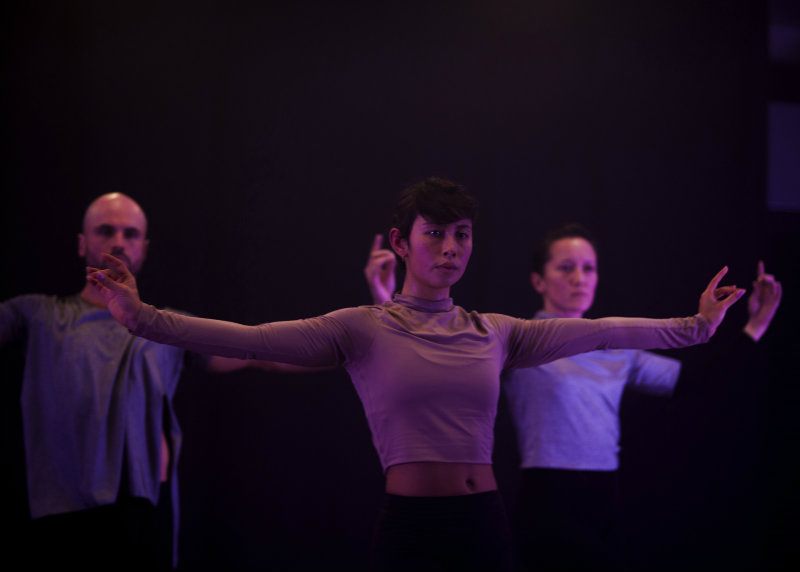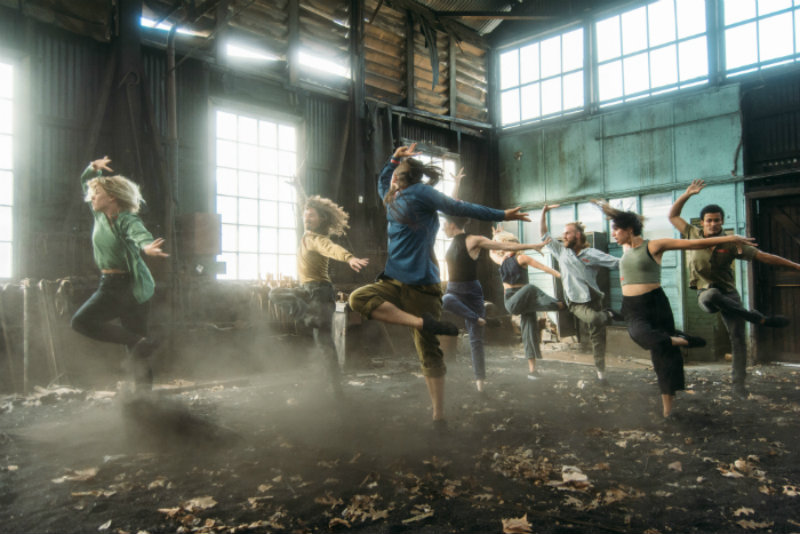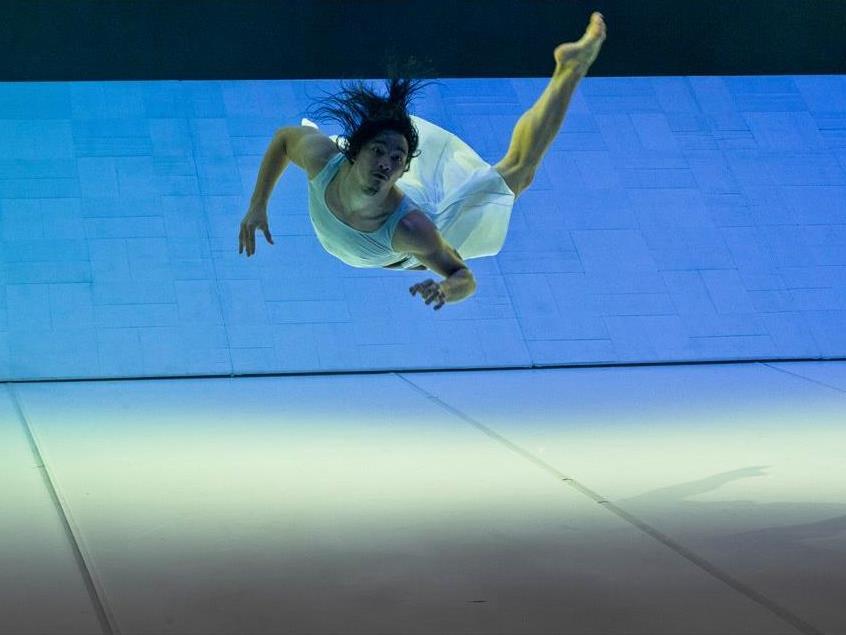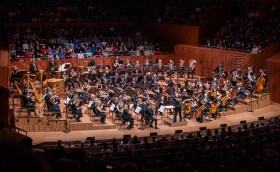A scene from Australian Dance Theatre’s Be Your Self. Photo credit: Chris Herzfeld – Camlight Productions
Responsible for designing and directing the movement sequences in dance, the choreographer’s art is not always the first thing audiences notice in a dance performance. But while the dancers themselves, as well as lighting and sound design, set and costume all enrich a performance, the choreographer’s art is the key element – providing not only a uniting vision, but a unique movement vocabulary, created upon the bodies of the company and sometimes even the choreographer themselves.
Garry Stewart, Artistic Director of Australian Dance Theatre (ADT) was studying social work at university when he discovered dance at the age of 20.
‘I had one of those lightning bolt moments when I saw my first dance performance and then realised this is what I needed to do. This was peculiar, as the only culture in our working class household as a kid was country and western music and bad 70’s television – certainly no exposure to dance. So I dropped everything and started full time training in dance, completely underestimating how difficult it really would be,’ he said.
‘Early on in this process I knew I wanted to be a choreographer – to make my own work, run a company, tour internationally. That was there from the beginning. It didn’t feel like an aspiration, it just felt like “of course this will happen”. I’m not 100% sure what that was about. It certainly wasn’t arrogance, but just a very deep seated belief that this was meant to happen. The bravura and certainty of youth I guess.’
Kyle Page, co- CEO and Artistic Director of Dancenorth, also came to choreography somewhat by chance.
‘It was definitely not a career move and very much something I fell into, quite literally, when I fell in love with Amber Haines,’ he explained.
‘Amber and I were working together at Australian Dance Theatre and began creating duets for ADT performances; this unlocked an entirely new interest in choreography which ultimately led to us traveling to Varanasi, India for three months with the support of Asialink where we developed Syncing Feeling. Until Amber entered my life I actually had very little desire to choreograph – I have always enjoyed making material in the studio but never felt compelled to sit on the outside looking in. Amber and I found such a beautiful synergy in our creative differences and such complementary yet often opposing approaches to making that there was really no avoiding it – we are collaborators in every sense of the word and I now can’t imagine doing anything else!’

Melanie Lane’s Nightdance. Image by Jody Hutchinson.
Originally from Canberra, and now dividing her time between Australia and Berlin, choreographer Melanie Lane credits one of her early dance teachers, Janet Karin, for developing her interest in the art form.
Karin, who ran the National Capital Ballet School in the 1980s and 90s, ‘was a fierce teacher and really nurtured her students by facilitating access to a spectrum of ways to experience dance,’ said Lane.
‘Part of her vision was to invite guest choreographers such as Joe Scoglio, Natalie Weir and Paul Mercurio to create new works, Indigenous artists to teach traditional dance, and an annual platform for students to create their own short pieces. I remember creating my first group piece at age 12 to Ennio Morricone’s “The Mission”, which was probably awful, but from then on I fell in love with making dances. I carried this interest with me through my years at WAAPA and have pursued it ever since.’
Artistic Director of Tasdance, Felicity Bott, also began dance training in Canberra at a young age, at the Contemporary Dance Centre.
‘My mother was a teacher and she specifically went looking for a dance school that was creative … so my first choreographic forays started as a child at the dance school that I attended. It began probably as improvisation in class, which I loved as much as the technique and the phrase work that we were learning,’ said Bott.
‘But then pretty quickly, in my primary school years, Ruth Osbourne used to run a choreographic workshop annually, so we were given the opportunity to make our own work. So my choreographic aspirations and experience just about parallels my training from the very beginning.’
Learning on the job
While formal training is available for would-be choreographers, it’s just as possible to fall into a choreographic career unexpectedly, Page explained.
‘I managed to skip Year Nine at school, then skip university training to find myself with a full time job in a company (Dancenorth) at 17, so I guess I align more closely with learning on the job! That said there are times in which I wish I could download a three year degree and have all of that amazing knowledge and history to draw from,’ he said.
‘Ultimately I feel that life is the best training ground. Being in the world and staying engaged and connected will lead you to open doors and opportunities – and if the doors are not wide open, it is unlikely that they are locked so I’d give them a push, and if they still don’t budge, I guess I’d pick the lock.’

Dancenorth & Lucy Guerin Inc’s Attractor features Indonesian music duo, Senyawa, and a cast of trained and untrained dancers. Image via www.brisbanefestival.com.au.
Stewart notes that there are various post graduate studies in choreography available, adding, ‘I certainly wouldn’t encourage anyone to steer clear of these as maybe the old school process of throwing you in the deep end isn’t necessarily ideal. It’s painful putting all of your mistakes up on stage in front a paying audience.’
Stewart did not undertake formal choreographic study himself. ‘I did however enrol in a Bachelor of Communications at the University of Technology Sydney, focussing on cultural theory studies and new media/film production,’ he said.
‘I realised that if I was going to be serious about choreography I needed an education. The introduction to post-modern theory, politics, writing etc. fed directly into my artistic work and laid the ground work for certain ways of critical thinking and of the necessity for research.’
Lane studied choreography at WAAPA, and notes that most tertiary performing arts faculties offer such training today.
She adds: ‘I think I learn the most when I work with others, whether it’s as a dancer, collaborator or choreographer. And of course experiencing other artists’ work is a huge part of gaining a broader understanding of the form. I know a number of choreographers that have cultivated their own choreographic practice without any formal training.’
Bott said a combination of formal and on the job training is increasingly common in today’s dance sector. ‘When I was at WAAPA we studied composition as part of our qualification. And then jumping ahead, 20-25 years later, I had three recent graduates in the Tasdance ensemble this year … who were given the opportunity to make their own choreography as part of a season we presented this year. I was blown away by the level of sophistication and how progressed their knowledge of composition was – not just their knowledge but their confidence around composition, and the way they identify with it as part of their practice, and I felt like that has been directly fostered by the tertiary institutions they’ve been at.
‘And in terms of learning on the job, that can happen in a range of ways – not only in learning to be a choreographer yourself but also working with other choreographers as a dancer.’
A day in the life
Every artist’s practice and processes are different. Page starts every day with a green juice before entering the studio to work with the company’s members.
‘At Dancenorth we begin each day with a 15 minute mindfulness practice with the entire ensemble – this is a wonderful way to separate the outside world with the creative space,’ he explained.
‘From here we dive into company class followed by rehearsals – we have recently been rehearsing on the beach for our latest work Tectonic so it’s been all about sunscreen and hats. Generally we spend our day in the studio, thinking, talking, researching, making, moving and creating… I get to spend my days surrounded by the most amazing humans and feel immensely grateful for that.’
Read: ArtsHub’s review of Tectonic
A typical day for Stewart depends on whether he is making a work or not, noting that the pattern during the making period is quite intense.
‘First thing in the morning I have my first coffee (I’m now trying to keep it at one a day. I used to have around five a day) and catch up on the news and check emails. I then write notes in preparation for the day’s rehearsal. Before walking out the door I try to meditate a bit, no matter how briefly.
‘At work I warm up with yoga and commence rehearsals. My breaks are usually taken up with meetings. We finish rehearsals at 6pm. After work I try to make it to the gym if only for 45 minutes. I go home and have a small dinner. I never make dinner appointments during the week or see performances or make any other commitments. I can only think about work during the week. I watch videos of the day’s rehearsal and also read material that is relevant to the work and advance some of the ideas. I go to bed around midnight.
‘I do the same thing the next day,’ he continued.
‘A rehearsal period for a new work is around three months in total. Sometimes it’s broken up and other times its one continuous creation period leading to the premiere.’
Lane said that one of the joys of working as a choreographer is that every day is different and unpredictable.
‘I often come to the studio with a plan, and then it all gets diverted and ends up completely on another trajectory. These are often the most exciting days. But generally speaking I enter a process by devising a specific training method that will lend itself as a catalyst for negotiating and generating choreographic ideas,’ she explained.
‘More recently I have been interested in inviting guest artists, from diverse disciplines and histories, into the studio to share ideas and experiences through workshops and conversations, based around a subject I’m interested in. I’ve found these experiences super valuable in informing my own choreographic process but also in learning from, and meeting new people,’ Lane said.
Career highlights and lowlights
Bott describes her career highlights as those dance works which are ‘coherent – the ones where you’ve brought all the elements together’.
She continued: ‘You’re not in a garret with canvas and oils – you’re working with an ensemble, and that’s just the beginning. Then sometimes you’re working with a dramaturg, lighting designer, costume designer, and to have all of those cabs pull up at the rank at the time of the premiere in ways that are not just meaningful and professional and exciting in themselves, but that somehow feed into this product that’s on the table, the work – sometimes those cabs arrive at the rank together in ways that are just so exciting and synergistic, and sometimes some come and some arrive late. And I feel if I was just to talk generally about lowlights and highlights, the highlights are when that all comes together and the lowlights are when work, despite everybody’s best intentions … somehow it’s not quite as coherent as you wanted and it’s not quite packing the punch you wanted.
‘And I just think that it’s a rare artist who hits that highlight every time,’ she said.

Tasdance’s Fragile Matter. Photo by Dermot McElduff.
Having commenced in the Artistic Director’s role at ADT in 1999, Stewart’s career highlights and lowlights are plentiful.
‘Of the highlights – creating Housedance for the Sydney Opera House for New Years Eve of the year 2000, then taking the company to the Sydney Opera House for the first time with Birdbrain. It felt like a homecoming as I am originally from Sydney and I’d only been in Adelaide for a year. There was such warmth and excitement in the audience. The Sydney Opera House was where I first discovered dance so it was really special to return there with my work,’ he said.
Other highlights for Stewart include presenting four of his shows at Théâtre de la Ville (‘arguably the world’s most important contemporary dance venue) and watching ADT’s dancers develop into extraordinary artists. ‘Some of them leave the company and evolve into choreographers, making work that is unique and inspiring,’ he said.
‘A definite lowlight was having the Australia Council move ADT out of the MPAB [Major Performing Arts Board] to the Dance Board for no other reason than the fact that the company had changed Artistic Directors. This happened just after I was appointed. This enforced move hasn’t happened to any other MPAB company before or since. It’s still a mystery to me why this occurred and it has had major ramifications on the evolution of the company since. Such a huge error of judgement in my opinion.’
Page is one of the dancers Stewart has seen grow into a remarkable artist and choreographer in his own right, so its perhaps unsurprising that one of his highlights ties back to his time at ADT.
‘I will never forget the moment Amber and I premiered our first full length work, Spectra, in Adelaide at the 2015 OzAsia Festival,’ Page said. ‘We received a full standing ovation and in the centre of the crowd stood Garry Stewart, my dear friend and Artistic Director of ADT – Amber and I had only recently left ADT to take over Dancenorth and seeing Gaz on his feet, smiling so generously and supporting our work was a very beautiful moment.’
For Lane, the return to Australia after working for many years in Berlin, was something of a shock.
‘A lowlight would probably be when I presented my first work in Australia after having spent 14 years abroad in Europe and it got throttled by reviewers. It was, and still is one of my favourite works, so that was quite a brutal entry back into the Australian landscape. In any case, as a result, it made me pretty thick skinned when it now comes to reviews,’ she said.
‘A highlight is feeling how lucky I am to have been embraced by such an amazing independent arts community. The Australian independent contemporary dance community is rich with inspiring and supportive folk who are active in seeing the progression of contemporary dance blaze forward. A super exciting community to be a part of.’
Practical advice
Asked what advice he would give to an aspiring choreographer, Stewart said: ‘My career advice is about tenacity. Certainly you get that from training as a dancer, which requires phenomenal determination. We all have highs and lows, make works that are quickly relegated to the dustheap and others that fortunately have a life and attract an audience and say something of value. These cycles are normal and never cease throughout your career.
‘The other advice to a young artist is about educating themselves as much as possible – read widely. I wish I had more time to read but I do what I can. Also conversations and connections – learning from others by maintaining an ongoing curiosity and willingness to reappraise what you know,’ he said.
Lane reflected on the challenges of sustaining a career as an independent practitioner.
‘One of the biggest challenges is keeping a sustainable practice afloat, and so I would definitely recommend persisting in creating, researching and developing ideas, whether it’s in the studio or the living room. I attempt to live by the idea of creating something new every day, whether it’s a bit of writing, a drawing, a collection of images or a choreography – even it fails or feels fragmentary. I don’t always manage it, but it’s a good way to try keep busy with developing a personal artistic practice,’ she said.
Bott stressed the importance of consistency. ‘If you can find a context that gives you consistent access to the practice of your choreography, do take that up and do try and create those circumstances for yourself. For me, that consistency was provided by being at the helm of a youth dance company, but for others it might be by attaching themselves to Dancehouse, or seeing how they can string together opportunities which flow and are foreseeable. The stop-start is hard. So I think it’s very important that you can somehow build consistency into your practice across time.’
Page speaks succinctly: ‘Stay curious, be engaged in the world, and never accept “no” on face value!’
ADT’s Be Your Self tours nationally from 18 August – 12 September 2017. See www.adt.org.au for details.
Dancenorth perform Attractor at Brisbane Festival from 20-24 September 2017. Details at www.brisbanefestival.com.au.
The world premiere of Melanie Lane’s Nightdance runs from 24 – 27 August 2017 at Arts House, North Melbourne. Visit artshouse.com.au and melanielane.info for details.
Learn more about Tasdance’s current activities at www.tasdance.com.au.
Previous articles in this series:
Career spotlight: Curator
Career spotlight: Arts publicist
Career spotlight: Collection manager
Career spotlight: Registrar
Career spotlight: Art therapist
Career spotlight: Burlesque performer
Career spotlight: Conservator
Career spotlight: Contemporary jeweller
Career spotlight: Costume designer
Career spotlight: Floral artist
Career spotlight: Playwright
Career Spotlight: Puppeteer
Career spotlight: Set Designer
Career spotlight: Stage manager





